AMD Ryzen 5 3600 Review: Why Is This Amazon's Best Selling CPU?
by Dr. Ian Cutress on May 18, 2020 9:00 AM ESTCPU Performance: Synthetic, Web and Legacy Tests
While more the focus of low-end and small form factor systems, web-based benchmarks are notoriously difficult to standardize. Modern web browsers are frequently updated, with no recourse to disable those updates, and as such there is difficulty in keeping a common platform. The fast paced nature of browser development means that version numbers (and performance) can change from week to week. Despite this, web tests are often a good measure of user experience: a lot of what most office work is today revolves around web applications, particularly email and office apps, but also interfaces and development environments. Our web tests include some of the industry standard tests, as well as a few popular but older tests.
We have also included our legacy benchmarks in this section, representing a stack of older code for popular benchmarks.
All of our benchmark results can also be found in our benchmark engine, Bench.
GeekBench4: Synthetics
A common tool for cross-platform testing between mobile, PC, and Mac, GeekBench 4 is an ultimate exercise in synthetic testing across a range of algorithms looking for peak throughput. Tests include encryption, compression, fast Fourier transform, memory operations, n-body physics, matrix operations, histogram manipulation, and HTML parsing.
I’m including this test due to popular demand, although the results do come across as overly synthetic, and a lot of users often put a lot of weight behind the test due to the fact that it is compiled across different platforms (although with different compilers).
We record the main subtest scores (Crypto, Integer, Floating Point, Memory) in our benchmark database, but for the review we post the overall single and multi-threaded results.
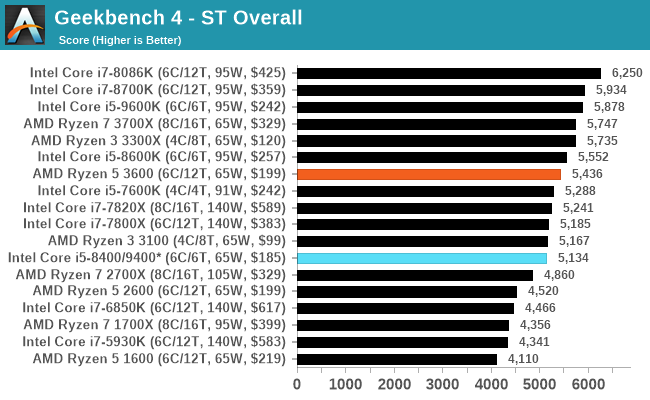
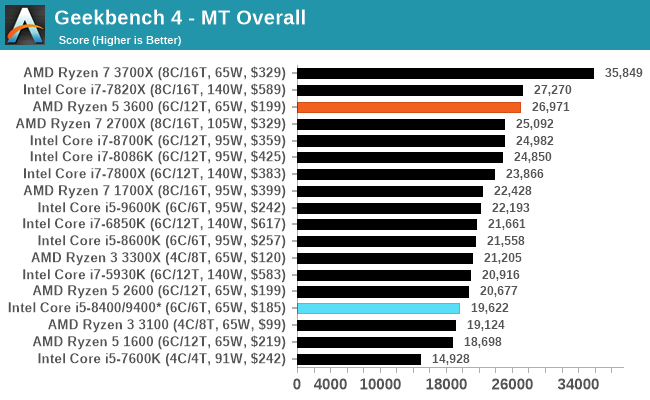
Speedometer 2: JavaScript Frameworks
Our newest web test is Speedometer 2, which is a accrued test over a series of javascript frameworks to do three simple things: built a list, enable each item in the list, and remove the list. All the frameworks implement the same visual cues, but obviously apply them from different coding angles.
Our test goes through the list of frameworks, and produces a final score indicative of ‘rpm’, one of the benchmarks internal metrics. We report this final score.

Google Octane 2.0: Core Web Compute
A popular web test for several years, but now no longer being updated, is Octane, developed by Google. Version 2.0 of the test performs the best part of two-dozen compute related tasks, such as regular expressions, cryptography, ray tracing, emulation, and Navier-Stokes physics calculations.
The test gives each sub-test a score and produces a geometric mean of the set as a final result. We run the full benchmark four times, and average the final results.
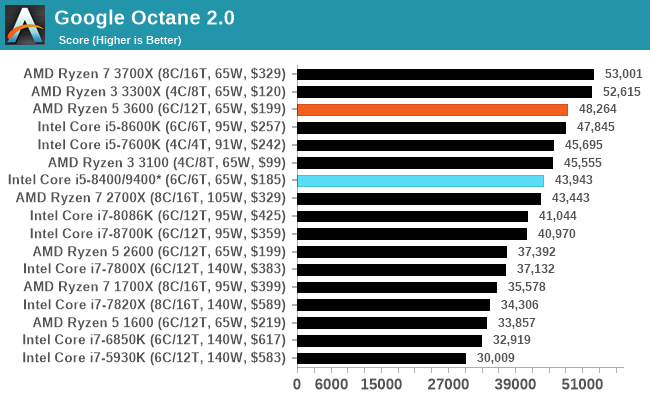
Mozilla Kraken 1.1: Core Web Compute
Even older than Octane is Kraken, this time developed by Mozilla. This is an older test that does similar computational mechanics, such as audio processing or image filtering. Kraken seems to produce a highly variable result depending on the browser version, as it is a test that is keenly optimized for.
The main benchmark runs through each of the sub-tests ten times and produces an average time to completion for each loop, given in milliseconds. We run the full benchmark four times and take an average of the time taken.
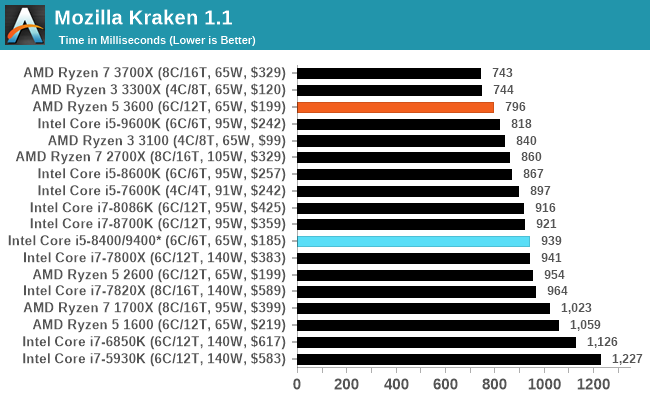
3DPM v1: Naïve Code Variant of 3DPM v2.1
The first legacy test in the suite is the first version of our 3DPM benchmark. This is the ultimate naïve version of the code, as if it was written by scientist with no knowledge of how computer hardware, compilers, or optimization works (which in fact, it was at the start). This represents a large body of scientific simulation out in the wild, where getting the answer is more important than it being fast (getting a result in 4 days is acceptable if it’s correct, rather than sending someone away for a year to learn to code and getting the result in 5 minutes).
In this version, the only real optimization was in the compiler flags (-O2, -fp:fast), compiling it in release mode, and enabling OpenMP in the main compute loops. The loops were not configured for function size, and one of the key slowdowns is false sharing in the cache. It also has long dependency chains based on the random number generation, which leads to relatively poor performance on specific compute microarchitectures.
3DPM v1 can be downloaded with our 3DPM v2 code here: 3DPMv2.1.rar (13.0 MB)
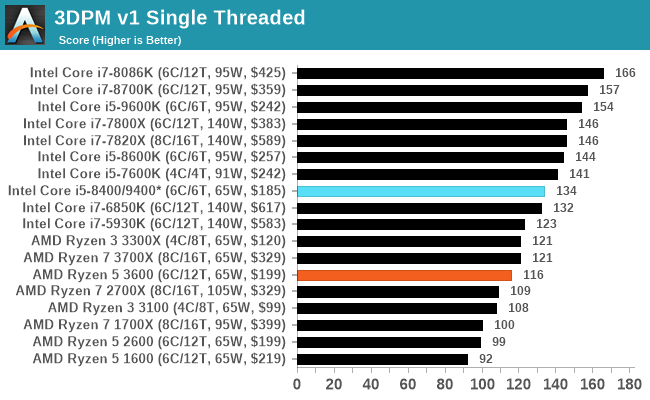
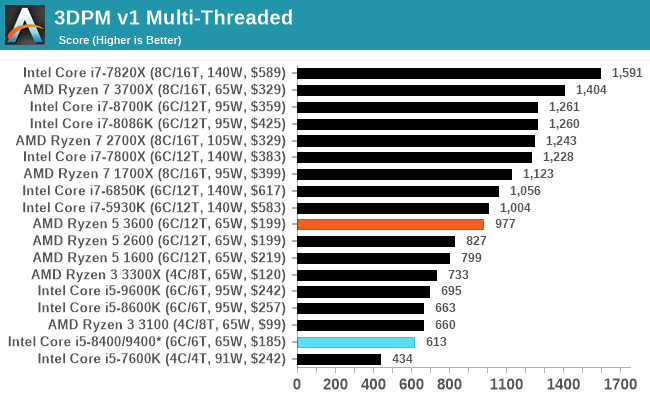
x264 HD 3.0: Older Transcode Test
This transcoding test is super old, and was used by Anand back in the day of Pentium 4 and Athlon II processors. Here a standardized 720p video is transcoded with a two-pass conversion, with the benchmark showing the frames-per-second of each pass. This benchmark is single-threaded, and between some micro-architectures we seem to actually hit an instructions-per-clock wall.

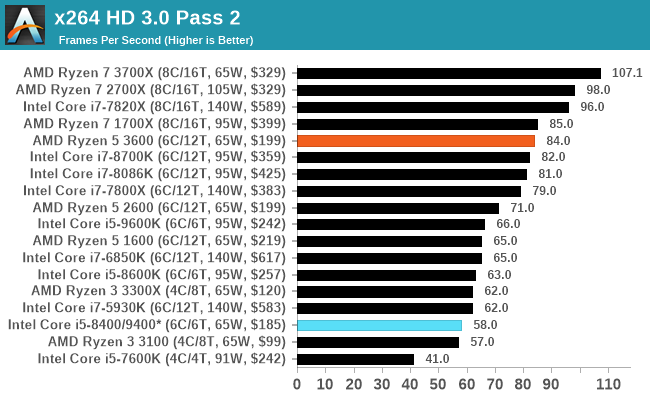










114 Comments
View All Comments
edzieba - Monday, May 18, 2020 - link
The "faster ram" columns always get a good laugh: anyone here running their DIMMs and /not/ using the XMP profiles?WaltC - Monday, May 18, 2020 - link
Right! What would be the point of that?...;) Intel isn't yet equal to AMD in architecture--still needs a bunch of vulnerability mitigation, and is still cranking out 14nm like there's no tomorrow...;) Intel's "high end" is in great demand, says Ian. Hmmm...I'll bet AMD's high end is even under higher demand--since Intel has very little if anything that can catch it. Zen 3 is going to fire another shot across Intel's bow...! Good times!PeachNCream - Monday, May 18, 2020 - link
Yeah, but how many desktop CPUs are getting sold directly to consumers versus the numbers going into more portable form factors or to OEMs for mass market Optiplexes and ProDesks? Those admittedly yawn-fest systems are where the volume sales are landing, not here with Gamer Billy's RGB LED-sled full ATX tower where though there are higher margins on a per-unit basis, the numbers just aren't significant.Icehawk - Wednesday, May 20, 2020 - link
Yeah, I’m not sure why they have a delusional disclaimer saying folks don’t use XML. Last time I checked this was a site for enthusiasts. Would really like them to test at stock and with a reasonable upgrade stick. A wider suite of benchmarks would be nice too.PeachNCream - Monday, May 18, 2020 - link
While the 3600 is currently the best selling desktop CPU on Amazon and it is great to see a competitive CPU landscape right now, occupying that number 1 slot is not representative of the wider PC market as a whole. A vanishingly small number of people elect to operate a desktop PC of any sort these days and of those people the majority do not build their own systems from individual components. Most of the world uses a mobile phone or a laptop to accomplish day-to-day compute tasks and get whatever CPU happens to be included in that system. I'm happy to see 4000-series APUs becoming more available so there is competition FINALLY in the price segments that see large sales volumes. It would be great if Anandtech could get hands on more practical and common hardware that the average person puts to use so the next time I go out to grab a sub-$500 laptop, I know if the cooling is sufficient or if it has dual channel memory. Maybe find out if there is something quirky about the touchpad. I have to drop in at notebookcheck.net most of the time for information that is relevant to me and their reviews are not usually as complete at AT, but AT appears to be very much out of the mobile hardware review business except for halo gamer hardware that relevant to a pretty small audience.WaltC - Monday, May 18, 2020 - link
Maybe it's just the difference in English, but why title the article "Why is the 3600 AMZN's best-selling CPU?" Almost sounds like Ian doesn't think it should be--but then the article itself corrects that misapprehension. Probably a better title would have been, "Here's why the 3600 is AMZN's best-selling CPU." Small change comment--nit picking, for sure...;) IMO, articles should never be titled as questions--a good article should inform, instead of leave unanswered questions. I was always taught that titling with questions instead of statements was second rate. A good article should include the answers--so instead of asking a question you let the reader know, "Herein lies the answer," etc.GreenReaper - Monday, May 18, 2020 - link
It doesn't meet the expectation that any news piece titled with a question can be answered "no", either!Icehawk - Wednesday, May 20, 2020 - link
One title is click bait, one is not. This is the world we live inflyingpants265 - Monday, May 18, 2020 - link
Hello. 3600 is still too expensive. $290 CAD when I paid only $100 CAD for my used 2600. So for me to upgrade, I'd be paying an extra $200.1_rick - Monday, May 18, 2020 - link
Comparing used prices to new isn't very useful.